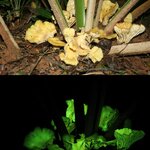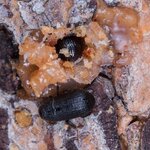Ecology & Zoology

After decades in ornithological obscurity, one of the world's least-known birds is finally coming to light thanks to the persistence of a small group of researchers; a year-long study of the Black Tinamou (Tinamus osgoodi hershkovitzi) has captured some of the first video and sound recordings of this elusive species.
The Black Tinamou is a chicken-sized bird found in the foothills of the eastern Andes, where it lives in tall, dense primary forest. It is extremely difficult to observe due to its secretive habitats and cryptic coloration.
For their study, the researchers focused on the…

An Australian Government report into the state of the Great Barrier Reef found that its condition in 2014 was "poor and expected to further deteriorate in the future". In the past 40 years, the Reef has lost more than half of its coral cover and there is growing concern about the future impacts of ocean acidification and climate change.
But science could restore the Great Barrier Reef to its former glory through better policies that focus on evidence-based policies, according to paper in Nature Climate Change. But all the stressors on the Reef need to be reduced for it to recover, so nothing…

Thousands of years ago, Aristotle knew that some mushrooms glowed, so it is no surprise the great thinker wondered why.
Science may finally have an answer for his question.
A new study posits that the light emitted from those fungi attracts the attention of insects, including beetles, flies, wasps, and ants. Those insect visitors are apparently good for the fungi because they spread the fungal spores around. The new study also shows that the mushrooms' bioluminescence is under the control of the circadian clock. In fact, it was that discovery that led the researchers to suspect that the…

Warming winters may be linked to mountain pine beetle outbreaks in the coldest areas of the western United States but the causes are multi-faceted, according to a new U.S. Forest Service study.
This is the first study to evaluate warmer winters as a factor permitting simultaneous outbreaks of mountain pine beetle across the majority of its range in the western United States.
In the last 15 years, bark beetles in the western U.S. have killed pine forests over more than 140,000 square miles (about the size of Montana), which exceeds the area killed by forest fires during the same…

When it comes to survival of the fittest, it's all about your mother, according to a study that analyzed 24 years' worth of data from a population of North American red squirrels in Canada's Yukon and measured maternal genetic effects in squirrel offspring.
Conclusion: Adaptive success in squirrels is often hidden in the genes of their mother. Biologists have debated "nature vs. nurture" for decades. To what extent are we born a blank slate and how much of our destiny in life is written out for us in terms of our genetics?
"Some squirrels are genetically better at being…

Nearly half of the 36 species of felids that live in the wild in the world are at threat, according to the International Union for Conservation of Nature advocacy group, and the main threat they all share in common is the loss and fragmentation of their habitat. That also limits the establishment of effective conservation strategies, according to a review of 162 articles related to Lynx pardinus, the Iberian lynx.
Despite conservation efforts, it still happens that the Iberian lynx, the most endangered felid in the world, is hit by vehicles on Spanish roads. To assess the situation of…

Shakespeare said "to be or not to be" is the question, and now scientists are asking how life forms grow to be the correct size with proportional body parts.
Probing deeply into genetics and biology at the earliest moments of embryonic development, researchers at Cincinnati Children's Hospital Medical Center report March 26 in Nature Communications they have found new clues to explain one of nature's biggest mysteries. Their data from fruit flies show the size and patterning accuracy of an embryo depend on the amount of reproductive resources mothers invest in the process before an egg leaves…

Cichlid fish in Lake Malawi know how to court and their courtship evolves - fast.
In the shallows where the light is good, males build sand castles to attract females, while deep-dwelling species dig less elaborate pits and compensate with longer swimming displays, according to a new study.
The researchers made a DNA-based "family tree" for 75 species (out of over 500) of Lake Malawi cichlids, noting for each whether males build castles or dig pits. The tree looks like a messy patchwork: the closest relatives of species with castle-building males often have pit-digging males, and…

A tiny parasite named Pleistophora mulleri not only significantly increases cannibalism among the indigenous shrimp Gammarus duebeni celticus but made infected shrimp more voracious, taking much less time to consume their victims.
Cannibalism is fairly common in nature but the belief was always that it is practical - meat is meat. Consumption of juveniles by adults is a normal feature of the shrimp's feeding patterns, but this is the first paper to show parasites cause it and even alter the feeding patterns - shrimp infected with the parasite ate twice as much of their own kind as…

Chitin is a molecule that forms hard structures like fungal cell walls and the exoskeletons of invertebrates such as insects and crustaceans. It forms a strong and pliable material that is made even stronger when complexed with other materials (such as proteins and minerals) to form the protective outer shells of insects and crustaceans.
Chitin is used in agriculture, industry and medicine. It naturally induces anti-fungal defense responses in plants, has been used in agriculture to protect against fungal infections and as a fertilizer. In addition, due to the malleable…